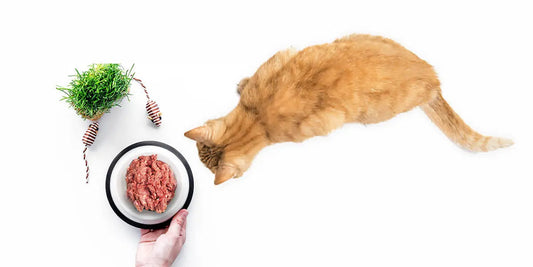
Lavish Your Dog with Healthy Balanced Fats
Written by Darwin's
Fatty foods aren’t just for banquets and feasts. The scientific evidence is overwhelming—dogs who eat balanced fat diets are healthier, happier and more intelligent than dogs who do not consume a proper balance of fats.
Darwin’s pays close attention to balancing the fats in their diets. This short blog will discuss why Darwin’s adds specific fats to each of its recipes. First, let me explain why “your dog is the fats she eats” and the importance of making sure you feed your dogs balanced-fat diets.
Balanced Fat Diets Produce Healthy Cell Membranes
The balance of fats a dog consumes has a profound influence on the dog’s cell membranes—the semi-permeable layers that allow cells to receive nutrients and eliminate wastes. Because every cell in the body has a cell membrane made mostly of omega-6 and omega-3 fatty acids, consuming the proper amounts of omega-6s and -3s has the potential to affect every organ system in the body.
A good dietary omega-6/-3 balance, which includes consumption of eicosapentaenoic acid (EPA) and docosahexaenoic acid (DHA), makes the cell membranes fluid, permeable, flexible, and healthy. On the other hand, too much omega-6 (from chicken fat, or corn, safflower, sunflower, and soy oils) makes the cell membranes (including those in the brain) brittle, sluggish, and inefficient. As a result, the dog thinks and moves a little slower. Likewise, too much DHA in the diet can make the cell membranes prone to oxidation, which leads to premature aging.
Balanced fat dog diets contain about 30-40% saturated fats, 30-50% monounsaturated fats, and 10-30% polyunsaturated fats, which include the omega-6 and omega-3 fatty acids. The amounts and balance—that is, the relative amounts—of the polyunsaturated fats are crucial. The ideal omega-6 to omega-3 ratio range is 2:1 to 6:1, and the omega-3s must include sources of EPA and DHA, two fats we get from fish, otherwise the fats are not balanced.
Balanced fat diets help dogs stay healthy as they age. However, poorly balanced fat diets, or, even worse, diets with rancid fats can create short and long-term health problems.
Many fats, especially the essential polyunsaturated fats, turn rancid with exposure to air. The fats we feed our dogs need to be of high quality and, most importantly, handled with care. Fats can become rancid quickly, and rancid fats can create chronic health problems, including diarrhea, liver and heart problems, macular degeneration, as well as cellular damage, cancer, arthritis and even death.
Most Kibble and Some Raw Diets Do Not Have Balanced Fats
EPA and DHA, essential fats especially for the brain and eyes, are just too fragile to be left open at room temperature. Think fish at room temperature. I recommend that kibble feeders avoid foods with added fish oils or sources of EPA and DHA, and, instead, add quality sources, like sardines, at time of serving. For full directions, please check my book, Unlocking the Canine Ancestral Diet.
Some raw food producers do not pay enough attention to balancing the fats. I have seen some poorly fat balanced raw chicken diets, some with pro-inflammatory amounts of linoleic acid (LA), an omega-6 fatty acid, and some raw beef diets with well below minimum recommended amounts for LA. My advice: always look for the omega-6 to omega-3 ratio, which should be listed on the company’s website. If the food contains sources of EPA and DHA, look for the best if used by date and buy fresh only. Raw foods kept in frost-free retail freezers have shorter shelf lives because of the temperature cycling.
Note: DHA is too fragile to be included in ANY FOOD meant to be kept on retail store shelves or freezers for up to 12 months and then, with dry foods, left open in the kitchen for up to four weeks.
How Darwin’s Balances Fats
To ensure that all of their products meet the needs of all dogs, even those that eat just one variety all the time, Darwin’s adds different fats to their poultry and beef and lamb foods.
Beef and lamb meats are high in saturated fats and low in polyunsaturated fats. Even the fattiest beef does not contain sufficient amounts of LA to meet the minimum recommended amounts. Darwin’s uses sunflower seed oils to provide LA and cod liver oil for EPA and DHA. Cod liver oil is also rich in vitamin D and other nutrients. The omega-6 to omega-3 ratios of Darwin’s beef is 4.1:1, and lamb is 2.9:1, both excellent.
With chicken and turkey foods, we are concerned about too much LA, which may exceed AAFCO and FEDIAF (European) maximums and can be pro-inflammatory, and high omega-6 to omega-3 ratios, leading to an unhealthy balance of fats in the cell membranes
Darwin’s uses lean chicken and turkey meats to ensure the proper amount of LA, and adds flaxseed oil and cod liver oil for an excellent balance of fats, with omega-6 to omega-3 ratios between 2:1 and 5:1 on all foods.
With Darwin’s duck foods, Darwin’s fine tunes the fatty acid profiles based upon the specific parts of the duck that Darwin’s uses for each batch.
Extra Credit: A Quick History of Essential Fats for Dogs
The science of fats is relatively new, and few dog professionals, including veterinarians, understand the importance of balanced fat diets. Fats represent a broad category of nutrients. Just as your dog needs to consume a variety of vitamins and minerals, your dog needs to consume a variety of fats.
Until recently, most nutritionists thought that the primary function of fat was to provide energy, flavor, and deliver vitamins. It was not until the 1980s—more than 30 years after the introduction of commercial dry foods—that most canine nutritionists understood that linoleic acid, an omega-6 fat, was essential. “Essential” means that the dog must consume the nutrient in the diet because she is unable to make the nutrient from other nutrients.
In 1985, the National Research Council (NRC) of the Academy of Sciences’ report titled Nutrient Requirements of Dogs and Cats listed linoleic acid (LA), an omega-6 fatty acid, as the only essential fat for dogs. Consumption of insufficient amounts of LA can lead to skin and coat problems, while too much LA can be pro-inflammatory.
By 2006, however, the NRC had updated its findings and listed four fats as essential for all dogs: LA, and three omega-3 fats: alpha linolenic acid (ALA), eicosapentaenoic acid (EPA) and docosahexaenoic acid (DHA).
Even though the NRC and almost all nutritionists consider DHA to be an essential fat for all life stages (reproduction, growth and adult), the Association of American Feed Control Officials (AAFCO) only considers it essential for reproduction and growth. Hence, DHA is not in most dry adult dog foods. In my opinion, that is good because DHA is too fragile to be in long-shelf life products.
In conclusion, on your journey on doing the best for your prince or princess, always be sure to check the fats used in the food you’re feeding your pet and supplement when needed with healthy, quality sources of fat like sardines.


